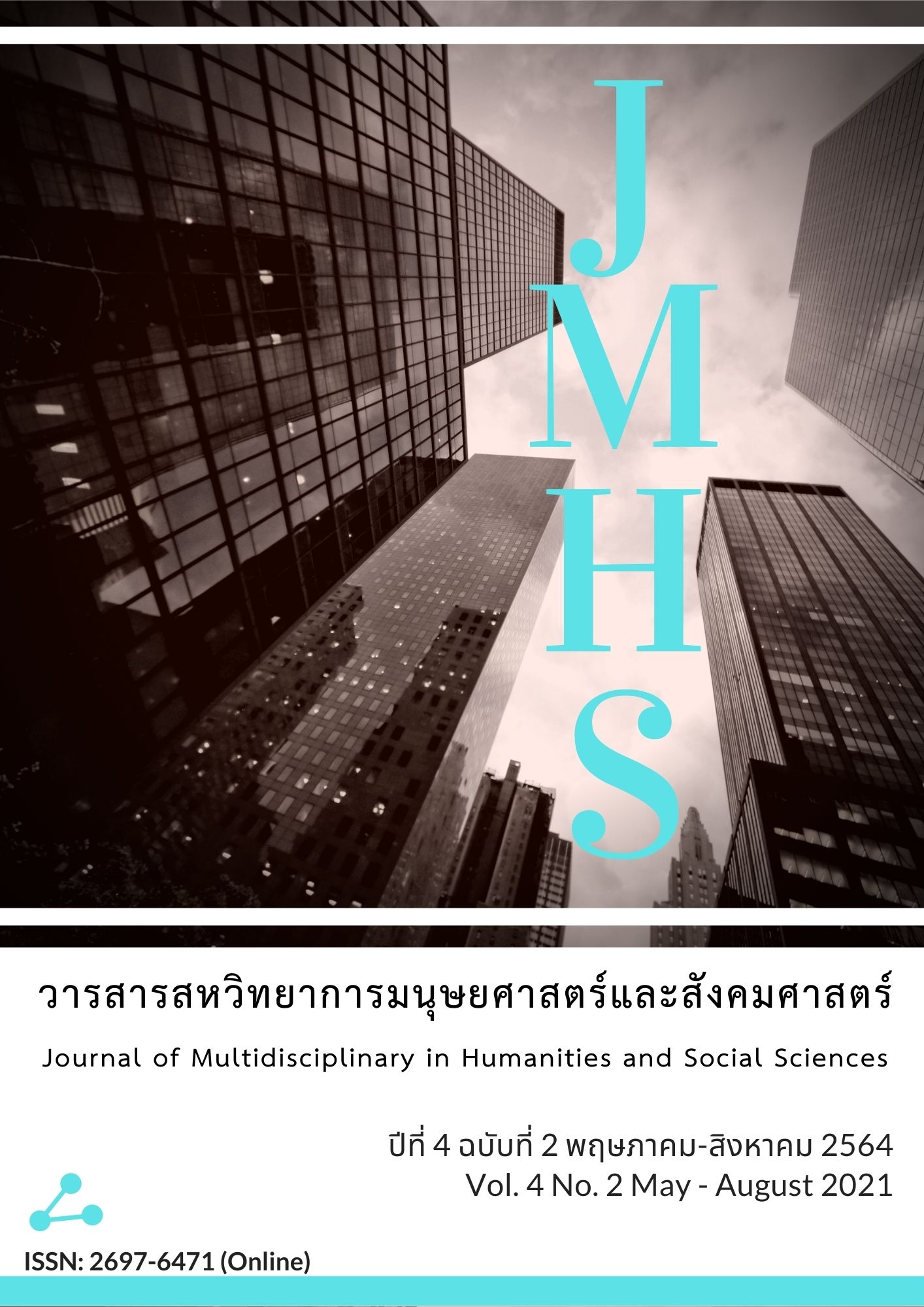Factors of Risk-Taking Behavior of Higher Secondary School Students Under The Jurisdiction of the Secondary Educational Service Area Office 2
Main Article Content
Abstract
The purpose of this study was to examine the factors of risk-taking behavior of higher secondary school students using the technique of stratified random sampling. The sample population consisted of 1,320 students under the jurisdiction of the Secondary Educational Service Area Office Two. Data were collected using a questionnaire and analyzed using the technique of exploratory factor analysis with principal component analysis and varimax rotation.
The findings showed that risk-taking behavior of the students under study consisted of the twelve factors. These were preferring challenges, imitating the commission of an offence, lacking discretion, neglecting health and personal hygienic condition, ignoring learning activities, violating school regulations, accepting improper environment, accepting incorrect practices, lacking self-responsibility, having false beliefs about drugs, seeing the commission of an offence as normal, and having wrong values in education. These twelve factors could be explanatory of the variance of risk-taking behavior of the students under study at 60.125 percent.
Article Details
Views and opinions appearing in the Journal it is the responsibility of the author of the article, and does not constitute the view and responsibility of the editorial team.
References
กรเกล้า สาลี. (2558). ปัจจัยทำนายพฤติกรรมเสี่ยงทางสุขภาพในเด็กวัยเรียนตอนปลาย(วิทยานิพนธ์พยาบาลศาสตรมหาบัณฑิต สาขาวิชาการพยาบาลเด็ก). มหาวิทยาลัยบูรพา.
กรมสุขภาพจิต. (2554). คู่มือครูที่ปรึกษาระบบดูแลช่วยเหลือนักเรียน. (พิมพ์ครั้งที่ 9). กรุงเทพฯ: โรงพิมพ์ชุมนุมสหกรณ์การเกษตรแห่งประเทศไทย จำกัด.
จรรยา เศรษฐพงศ์. (2550). พฤติกรรมเสี่ยงต่อสุขภาพของวัยรุ่นในจังหวัดนครศรีธรรมราช. วารสารการพยาบาลและการศึกษา, 3(3), 51-63.
จริยา ทรงพระ, นฤมล ศราธพันธุ์ และ อังคณา ขันตรีจิตรานนท์. (2558). ปัจจัยที่สัมพันธ์กับพฤติกรรมการใช้ความรุนแรงของนักเรียนชั้นมัธยมศึกษาตอนปลายในกรุงเทพมหานคร. วารสารศึกษาศาสตรปริทัศน์, 30(3), 96-109.
เจตน์สฤษฎิ์ สังขพันธ์ และ คณะ (2563). ปัจจัยที่มีอิทธิพลต่อพฤติกรรมเสี่ยงใช้สารเสพติดของเยาวชนไทยในอำเภอหาดใหญ่ จังหวัดสงขลา. วารสารศึกษาศาสตร์ มหาวิทยาลัยสงขลานครินทร์ วิทยาเขตปัตตานี, 31(3), 88-103.
บุรฉัตร จันทร์แดง. (2560). ปัจจัยที่มีผลต่อพฤติกรรมเสี่ยงต่อยาเสพติดของนักเรียนชั้นมัธยมศึกษาตอนต้น โรงเรียนดงหลวงวิทยา อำเภอดงหลวง จังหวัดมุกดาหาร(วิทยานิพนธ์รัฐประศาสนศาสตรมหาบัณฑิต สาขาวิชารัฐประศาสนศาสตร์). มหาวิทยาลัยราชภัฏ
มหาสารคาม.
เบญจพร ธิหลวง. (2558). พฤติกรรมสุขภาพของนักเรียนมัธยมศึกษาตอนปลายในอำเภอดอยหล่อจังหวัดเชียงใหม่. วารสารบัณฑิตวิจัย มหาวิทยาลัยราชภัฏเชียงใหม่, 6(1), 78 – 91.
ปิยพร สิงห์คำ. (2560). บริบททางสังคมที่มีความสำคัญต่อการดื่มเครื่องดื่มแอลกอฮอล์และการรับรู้ความสามารถของตนเองในการปฏิเสธการดื่มเครื่องดื่มแอลกอฮอล์ของนักเรียนชั้นมัธยมศึกษาตอนต้น โรงเรียนดงเจนวิทยาคม อำเภอภูกามยาว จังหวัดพะเยา. วารสารมหาวิทยาลัยคริสเตียน, 23(2), 193 – 205.
พัชรพรรณ คูหา. (2558). ปัจจัยที่มีความสัมพันธ์กับการดื่มเครื่องดื่มแอลกอฮอล์ของนักศึกษาหญิงในมหาวิทยาลัยจังหวัดเชียงใหม่(การค้นคว้าอิสระสาธารณสุขศาสตรมหาบัณฑิต). มหาวิทยาลัยเชียงใหม่.
ศุภวดี บุญญวงศ์. (2555). การป้องกันและแทรกแซงเส้นทางเข้าสู่พฤติกรรมเสี่ยงของเด็กและเยาวชนไทยฐานคิดสำหรับการแนะแนวและการให้คำปรึกษา. สงขลา: เทมการพิมพ์.
ศูนย์วิจัยปัญหาสุรา. (2557). เรื่องเหล้า ก้าว 10. กรุงเทพฯ: โรงพิมพ์เดือนตุลา.
สุรศักดิ์ อมรรัตนศักดิ์. (2557). เทคนิคทางสถิติเพื่อการวิจัย. (พิมพ์ครั้งที่ 5). กรุงเทพฯ: สำนักพิมพ์ศูนย์ส่งเสริมวิชาการ.
สุวรรณดา สงหนู. (2558). ปัจจัยที่มีผลต่อการรับรู้ความเสี่ยงและพฤติกรรมการป้องกันและควบคุมความเสี่ยงจากการทำงานของบุคคลากรแผนกผงซักฟอก(วิทยานิพนธ์วิทยาศาสตรมหาบัณฑิต สาขาวิชาการจัดการระบบสุขภาพ). มหาวิทยาลัยสงขลานครินทร์.
อรอนงค์ ซ้ายโพธิ์กลาง. (2557). ทุนสุขภาพกับพฤติกรรมเสี่ยงต่อสุขภาพของวัยรุ่น(วิทยานิพนธ์ศิลปศาสตรดุษฎีบัณฑิต สาขาวิชาประชากรศาสตร์). จุฬาลงกรณ์มหาวิทยาลัย.
Atorkey, P., & Owiredua, C. (2021). Clustering of Multiple Health Risk Behaviors and Association with Socio-Demographic Characteristics and Psychological Distress Among Adolescents in Ghana: A Latent Class Analysis. SSM - Population Health, 13, 100707. doi:10.1016/j.ssmph.2020.100707
Campbell, R., Wright, C., Hickman, M., Kipping, R. R., Smith, M., Pouliou, T., & Heron, J. (2020). Multiple Risk Behavior in Adolescence Is Associated with Substantial Adverse Health and Social Outcomes in Early Adulthood: Findings from A Prospective Birth Cohort Study. Preventive Medicine, 138, 106157. doi: 10.1016/j.ypmed.2020.106157
Hair, J. F., Black, W. C., Babin, B. J., & Anderson R. E., (2010). Multivariate Data Analysis. (7th ed). New Jersey: Pearson.

